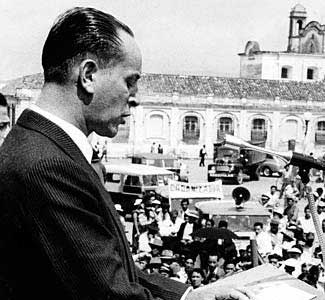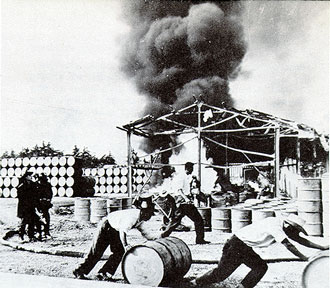
Jacobo Arbenz
The CIA was established in 1947—the same year Washington served
notice that its support for Latin American democracy was conditional
on the maintenance of order-and began to develop contacts among
military officers, religious leaders, and politicians it identified as bulwarks
of stability. Yet it was not until 1954 that it would execute its
first full-scale covert operation in Latin America, overthrowing
Guatemalan president Jacobo Arbenz and installing a more pliant successor.
Arbenz, as CIA analysts and most historians today admit, was
trying to implement a New Deal-style economic program to modernize
and humanize Guatemala's brutal plantation economy. His only
crime was to expropriate, with full compensation, uncultivated United
Fruit Company land and legalize the Communist Party—both unacceptable
acts from Washington's early-1950s vantage point.
Operation PRSUCCESS, as the CIA called its Guatemalan campaign,
was the agency's most comprehensive covert action to date,
much more ambitious than its operations in postwar Italy and France
or in Iran the year before. Unlike the ouster of the Iranian prime
minister, Mohammad Mossadeq, which took a mere couple
of weeks, Arbenz's overthrow required nearly a year.

Gasoline depot bombed by CIA rebel air force
In addition to
destabilizing Guatemala's economy, isolating the country diplomatically
through the OAS, and training a mercenary force in Honduras,
the Guatemalan campaign gave CIA operatives the chance to tryout
new psych-war techniques gleaned from behavioral social sciences.
They worked with local agents to plant stories in the Guatemalan
and U.S. press, engineer death threats, and conduct a bombing
campaign—all designed to generate anxiety and uncertainty.
They organized
phantom groups, such as the "Organization of Militant Godless,"
and spread rumors that the government was going to ban Holy
Week, exile the archbishop, confiscate bank accounts, expropriate all
private property, and force children into reeducation centers. Operatives
studied pop sociologies and grifter novels and worked closely
with Edward Bernays, a pioneer in public propaganda (and Sigmund
Freud's nephew), to apply disinformation tactics. Borrowing from
Orson Welles's War of the Worlds, they transmitted radio shows—taped
in Florida and beamed in from Nicaragua—that made it seem as
if a widespread underground resistance movement were gaining
strength; they even managed to stage on-the-air battles.
In the 1950s, the Cold War was often presented as a battle of
ideas, yet CIA agents on the ground didn't see it that way. They
rejected the advice of their Guatemalan allies that the campaign
include an educational component, instead insisting on a strategy intended
to inspire fear more than virtue . Propaganda designed to "attack
the theoretical foundations of the enemy" was misplaced, one
field operative wrote; psychological efforts should be directed at the
"heart, the stomach and the liver (fear)." We are not running a
popularity contest but an uprising," rejoined one agent to Guatemalan
concerns that the campaign was too negative. U.S. planes flew low
over the capital, dropping propaganda material, which for a region
that hadn't seen aerial warfare since the marine campaign against
Sandino sent a message beyond what was printed on the flyers. "I
suppose it doesn't really matter what the leaflets say," said Tracy
Barnes, who led the operation.
The "most effective leallet drops during the operations," concluded
a CIA postmortem of the coup, "were those followed by a successful
military blow." Such blows were delivered by CIA assets in
country, who bombed roads, bridges, military installations, and property
owned by government supporters. The agency distributed sabotage
manuals that provided illustrated, step-by-step instructions on
how to make pipe bombs, time bombs, remote fuses, chemical, nitroglycerine,
and dynamite bombs, even explosives hidden in pens, books,
and rocks. A how-to guide exhorted Guatemalans to take up violence
in the name of liberty, noting that "sabotage, like all things in life, is
good or bad depending on whether its objective is good or bad."
Such a "terror program" worked. Arbenz fell not because psych
ops had won the hearts and minds of the population but because the
military refused to defend him, fearing Washington's wrath if it repelled
the mercenaries.
At least some American leaders were fully aware that the
Guatemalan intervention marked a watershed in inter-American relations,
and they did their best to limit its damage. Assistant Secretary
of State Mann, for example, admitted in a private memo that
CIA efforts to oust Arbenz represented Washington's first full-scale
"violation of the Non-intervention Agreement," the "first of its kind
since the establishment of the Good Neighbor Policy." Yet he hoped
to hold on to the idea of the Good Neighbor policy, even as the
United States corrupted its language and institutions. He therefore
gave instructions that each step in the coup "should be justified on
technical grounds" to allow the United States to claim plausibly that
it was acting within the letter, if not the spirit, of Roosevelt's nonintervention
pledge.
But on the heels of Guatemala came Cuba in 1959, a revolution
that the CIA found itself powerless to reverse—even though it modeled
its 1961 Bay of Pigs invasion, which sought to topple Castro, on
its earlier successful Guatemalan operation. Cuban revolutionaries
learned well from the Guatemalan experience. Ernesto "Che" Guevara
in fact was in Guatemala in 1954, having concluded his famous
motorcycle tour of South America to work as a young, socially conscious
doctor. He witnessed firsthand the effects of U.S. intervention,
taking refuge in the Argentine embassy, where he would meet
a number of other future Latin American revolutionaries. After a
time cooling his heels, he won safe passage to Mexico, where he
joined Fidel Castro's revolutionary movement in exile. "Cuba will
not be Guatemala," he liked to taunt Washington.
Empire's Workshop, Greg Grandin